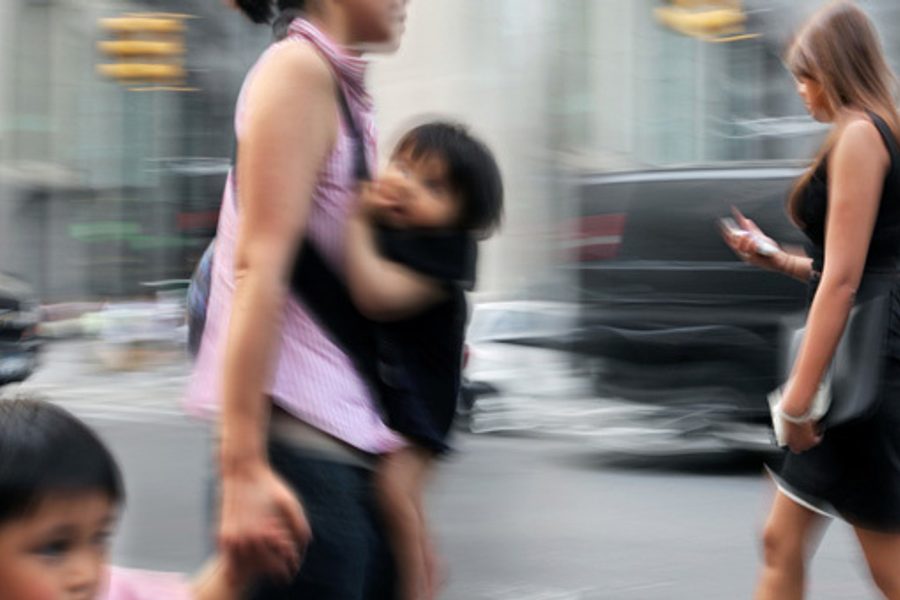Attachment Parenting: Beyond the Backlash
Once again, women are accused of killing feminism.
Jude Ellison Sady Doyle

Ever heard of “attachment parenting”? If you’ve spent more than five minutes on the Internet, or reading a magazine, the answer is yes. The New York Times ran a panel on the controversial child-raising strategy — which recommends, among other things, that a mother sleep with her baby, carry her at all times, and breastfeed for an extended period — under the oh-so-subtle title “Motherhood vs. Feminism.” Last week, Time magazine did the newspaper one better, running a sensational, meme-friendly cover of a pretty woman breastfeeding her toddler to promote an article about attachment advocate Bill Sears (who, apparently, could not be pictured on the cover because he wouldn’t take his top off). Countless women have weighed in on what attachment parenting means for womanhood today.
So: Another day, another group of women accused of killing feminism with their personal decisions. Business as usual.
Of course, attachment parenting does have very troubling undertones. For one, attachment parenting organizations and websites heavily imply that parents — especially mothers — should not have autonomous lives or priorities outside of childcare, and preferably should not work.
“Babies and young children have an intense need for the physical presence of a consistent, loving, responsive caregiver: ideally a parent,” according to the website for Attachment Parenting International (API). The “ideal” caregiver is constantly available; the website encourages parents to take their children along on dates, while exercising, and everywhere else. And, of course, children should also share the caretaker’s bed to ensure full 24-hour contact. After any time away from your child, you must “spend very focused and intentional time reconnecting,” presumably to heal the trauma caused by selfishly attending yoga class, having sex with your partner, seeing friends, or even sending the child to school. (Jamie Lynne Grumet, the attachment advocate on Time’s cover, home-schools her children.)
API’s website is coy about what this means for employment. If the child receives care from anyone other than its parents, that person must be extensively trained in attachment techniques; a regular babysitter or daycare isn’t okay. But if you can’t afford an attachment-specialist nanny, well: “Explore a variety of economic and work arrangement options to permit your child to be cared for by one or both parents at all times,” it says, tactfully burying the lede. Of course, the vast majority of “economic and work arrangement options” won’t allow 24/7 child contact unless a parent is unemployed or severely underemployed. And it’s unlikely that the partner tasked with giving up on their career will be male.
At Slate, Hanna Rosin makes the point that the movement is emotionally repressive, demanding that women sacrifice autonomy in favor of 24-hour motherhoood, and making them feel guilty for not enjoying it. “Attachment parenting demands not just certain actions you take with your baby but also certain emotional states to accompany those actions,” she writes. “So, it’s not just enough to breast-feed but one has to experience ‘breast-feeding induced maternal nirvana.’”
Fair enough. All told, attachment parenting’s demand for women to forgo serious careers or personal autonomy, focus their entire attention on their children, shut the world out, and perhaps even keep their children from school, makes it seem like a crunchy, granola-flavored version of the conservative Christian Quiverfull movement. Dr. William Sears, attachment parenting’s most famous advocate, was an evangelical Christian until recently, suggesting that the two movements might have more in common than we’ve been led to believe.
And yet the conversation around it is often galling. There’s been a lot of ire directed at attachment parenting. And there have been plenty of people willing to celebrate the death of feminism in its name, or shame women who don’t follow its practices. But both the defenders of attachment parenting and its critics tend to focus their ire on the same people: women.
Grumet, the mother on Times’s cover, has been turned into a flash-in-the-pan media sideshow. Rosin wrote an entire article about the harm attachment parenting might do to women, but seemingly couldn’t avoid calling the women who do it “attachment freaks” or lashing out at Grumet, saying that “her blog’s name alone [‘I Am Not The Babysitter’] is so obnoxious that I don’t care to delve further.” Well, wait: Are they a vulnerable group of oppressed women for whom Rosin is advocating, or are they a bunch of obnoxious freaks to be dismissed without a hearing? The contradiction doesn’t seem to occur to Rosin. Another woman, Bobbi Miller, expressed her disapproval of Grumet both on Twitter and in a phone interview, where she told AP that “even a cow knows when to wean their child.” So, add “comparing women to cows” to the victories racked up in this debate, I guess.
Yes, the tenets of attachment parenting are regressive, and even potentially anti-feminist. But it’s unlikely that the individual women who practice them are going to be feminism’s downfall. What might actually kill feminism is our preference for shaming and tearing down individual women rather than advocating overdue policy changes around child-rearing: Pushing for mandatory long-term maternity or paternity leave, or high-quality childcare for all children, or a new ethos of work that doesn’t penalize parents (usually mothers) for trying to maintain a healthy and flexible work-life balance.
All of these are feminist goals, and have been for quite some time. They might legitimately create an environment in which people can freely choose the parenting strategies that work best for their families. But when we’re busy yelling at individual mothers for their choices, or evaluating their feminism accordingly, those goals are exactly what we fail to focus on, or achieve.
Jude Ellison Sady Doyle is an In These Times contributing writer. They are the author of Trainwreck: The Women We Love to Hate, Mock, and Fear… and Why (Melville House, 2016) and was the founder of the blog Tiger Beatdown. You can follow them on Twitter at @sadydoyle.








